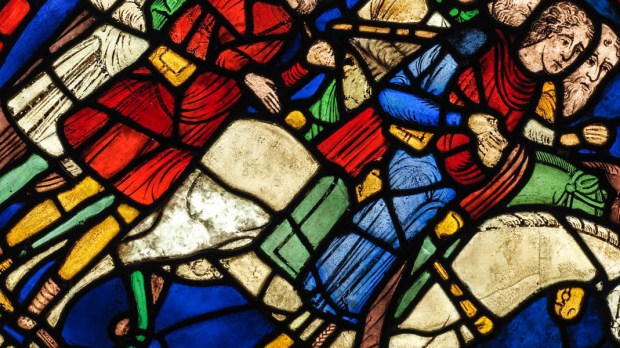A group of researchers has discovered that two stained glass panels at Canterbury Cathedral date back to the 1180s—much earlier than had been previously assumed, according to several reports.
The panels are part of the series of Miracle Windows that depict pilgrims at the shrine to St. Thomas Becket at Canterbury Cathedral. The earlier date of the two panels, which were once believed to be the work of Victorian restorers, places them a little more than a decade after Becket’s martyrdom, which was in 1170. Stories of pilgrims at the shrine were also later recounted in Chaucer’s Canterbury Tales, written two centuries later.
According to The Times, the panels are “now the earliest known artworks depicting pilgrims traveling to Canterbury.”
Researchers at Canterbury Cathedral have discovered that a stained glass window thought to be Victorian actually dates back to the 12th century. pic.twitter.com/AqXjRtrfmd
— BBC South East (@bbcsoutheast) September 5, 2018
“This discovery is terrifically exciting. We are delighted to be able have this opportunity for close-up analysis of the panels which has provided us with fresh information such as being able to read the inscriptions which had previously been deemed illegible,” said Leonie Seliger, the Director of Canterbury’s Stained Glass Studio, according to an article on the cathedral website.
The panels are part of the Miracle Windows, so named after a series of miracles they recount as having occurred at the tomb of the saint, from the time of his death to the early 1200s, according to the cathedral website.
One of the medieval panels depicts a pilgrim on crutches, seeking healing from his disability. “The incredible detail includes the bright green and yellow boots of the pilgrims, which were painted with horizontal stripes and a polka dot decoration. This highly elaborate footwear may have been meant to underline the importance of the pilgrimage,” the cathedral description states.
Becket was murdered at the behest of Henry II because the archbishop refused to let clergy stand trial in secular courts. Far from being just jurisdictional squabble, the future independence of the Church hinged on the outcome of the conflict. In many ways, the incident would foreshadow the clash between St. Thomas More and Henry VIII several centuries later (see this source here).
Catholic historian Warren Carroll has written that Becket’s martyrdom was one of the most important events in medieval Christendom. As he puts it, it has been “seared into the history of Christendom as by a branding iron. Books, poems, sagas, plays, and the tales of millions of pilgrims over eight centuries have lovingly traced and enshrined every detail of that unforgettable murder in the cathedral (Glory of Christendom, 106).
The martyr’s shrine became one of the most popular and venerated destinations for pilgrims in the Middle Ages.

